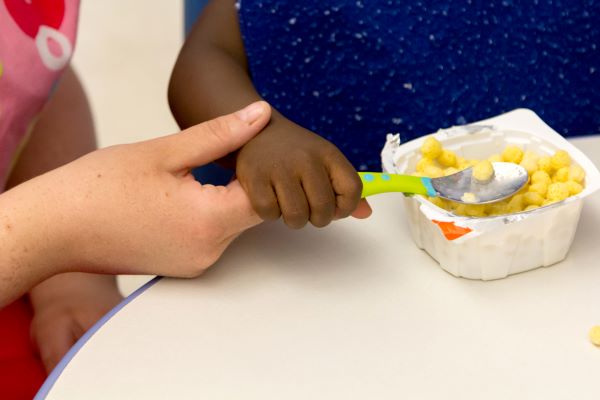 From conception to age 2, children grow and develop fast. Infants and toddlers develop their food preferences more during this period than at any other time in their development. Humans are born with a built-in preference for sweet flavors over sour and bitter flavors. Head Start programs can influence a child’s acceptance of many flavors by exposing or reintroducing infants, toddlers, and preschoolers to nutritious foods with different flavors and textures.
From conception to age 2, children grow and develop fast. Infants and toddlers develop their food preferences more during this period than at any other time in their development. Humans are born with a built-in preference for sweet flavors over sour and bitter flavors. Head Start programs can influence a child’s acceptance of many flavors by exposing or reintroducing infants, toddlers, and preschoolers to nutritious foods with different flavors and textures.
Focusing on food alone is not enough. Children, especially infants, benefit from positive, responsive feeding environments. Health managers can support staff to feed infants and toddlers according to their individual development and feeding skills, and make sure they feed infants and young toddlers on demand to the extent possible. For bottle-fed infants, this approach must include holding infants during bottle feeding, and never laying them down to sleep with a bottle.
Breastfeeding or Chestfeeding
Programs are required to promote breastfeeding or chestfeeding. Programs can make referrals to lactation consultants or counselors if needed. While human milk offers ideal nutrition for babies, not everyone chooses or is able to breastfeed or chestfeed their infant. It’s important for every Head Start family to feel supported in their infant feeding choice and for every baby to receive age-appropriate nutrition.
Chestfeeding or bodyfeeding can refer to feeding a baby milk directly from the body. These terms are used by people who don’t use the word “breast” for their anatomy. To many, these terms can feel more neutral than breastfeeding or nursing.
Conversations about breastfeeding or chestfeeding can start during pregnancy. This allows the family time to consider all their options. Creating a welcoming environment for breastfeeding or chestfeeding families can give a sense of comfort that may be missing in other parts of the community. Programs can offer an environment that makes families feel comfortable during program hours. This will be a clean, private space for parents with a comfortable chair, pillow, sink, and electrical outlet for expressing human milk. Programs can promote breastfeeding or chestfeeding when they have proper storage, policies, procedures, and staff support and training on the safe handling of human milk.
Sometimes a parent cannot breastfeed or chestfeed. Putting pressure on these parents could make them anxious or depressed, and pressuring families is not aligned with the Head Start approach to family partnerships. Programs can offer help to find a feeding solution that meets the baby’s nutritional needs and supports the parent’s psychological well-being. Programs can help families by helping them get formula and learn how to mix it properly. A program must use Head Start funds for formula (and diapers) for enrolled children during the program day.
The health manager can invite WIC or local lactation consultants to join the HSAC to discuss services and supports available to families. The consultants can also help find service gaps and barriers that new families face in the community.
Developmental Milestones in Feeding
 Several motor skills and behavioral changes play a role in the development of an infant’s eating habits and ability to eat and drink. Recognizing children’s body language, facial expressions, and physical behavior can help caregivers feed infants and toddlers.
Several motor skills and behavioral changes play a role in the development of an infant’s eating habits and ability to eat and drink. Recognizing children’s body language, facial expressions, and physical behavior can help caregivers feed infants and toddlers.
While not every child reaches developmental milestones at the same time, research shows children often progress in these ways:
- Transitioning from human milk or iron-rich formula to smooth, single-ingredient purées, to combination foods (purées with more than one ingredient)
- Transitioning between types of utensils used: from bottles to spoons and forks, to open cups and straws
- Transitioning from being fed to self-feeding, holding their own bottle, feeding themselves with fingers, and on to independently using utensils
The primary eating milestones are:
- Drinking from the bottle or breast or chest
- Eating from a spoon
- Biting foods
- Drinking from a “sippy” cup
- Drinking from an open cup
- Sipping from a straw
- Thoroughly chewing foods
- Self-feeding
Tips and Strategies for Feeding Infants and Toddlers
- Educate staff and families about responsive feeding.
- Support breastfeeding or chestfeeding in your program.
- Give staff and families resources about feeding milestones.
- Help staff and families learn about age-appropriate foods and serving sizes.
Learn More
- Infant and Toddler Nutrition
- Feeding Infants in the Child and Adult Care Food Program
- Mealtimes with Toddlers in the CACFP
- Breastfeeding and Infant Nutrition
- CFOC 9.2.3.12: Infant Feeding Policy

Tummy Time for Infants
Infants (0-12 months) should get short, supervised periods of tummy time two or three times a day. Tummy time is the times when a baby is placed on their stomach while they are awake and alert, and someone is watching. Some babies don’t like tummy time at first, so the time can begin with only three to five minutes at one time. Staff can encourage babies to reach for a favorite toy, or they can sing to the baby. Then they can increase the time when they see the infant enjoying it more. As babies grow older, more tummy time helps build strength for sitting up, rolling over, crawling, and walking.
Tips and Strategies for Infant Physical Activity
- Encourage babies to see, touch, and feel what’s around them.
- Place toys in a circle around the baby and let the baby reach for them.
- Place babies on a solid surface on the floor (never on a surface that’s soft or up high like a mattress or sofa).
- A great time to do tummy time is after a diaper change or when the baby wakes up from a nap.
Learn More
- Let’s Talk About Movement
- Supporting Outdoor Play and Exploration for Infants and Toddlers
- Top 5: What You Need to Know About Tummy Time
- Healthy Habits for Life
- Fitness and Your 2- to 3-Year-Old
Read more:
Resource Type: Article
National Centers: Health, Behavioral Health, and Safety
Audience: Directors and Managers
Last Updated: March 4, 2024